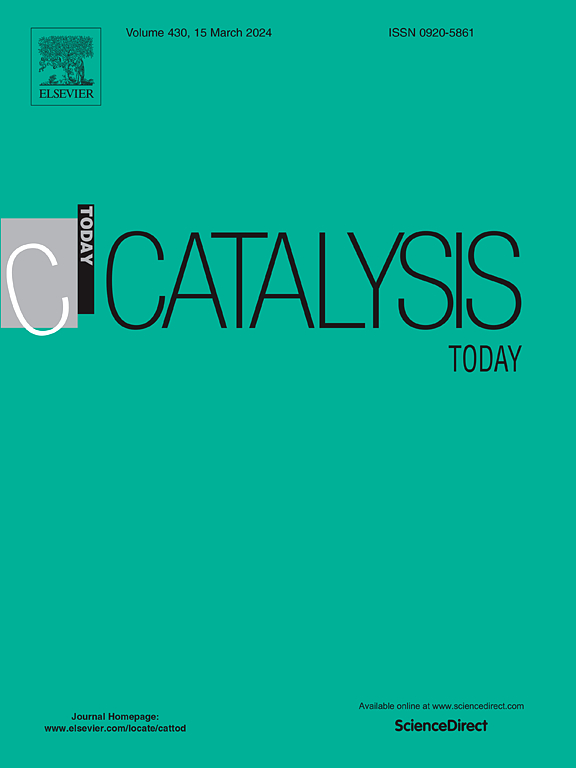脱除二甲基二硫的非热等离子体/光催化工艺:催化剂中毒的研究与减少
IF 5.3
2区 化学
Q1 CHEMISTRY, APPLIED
引用次数: 0
摘要
本文采用两种氧化工艺对气态二甲基二硫化物(DMDS)进行了脱除:在玻璃纤维组织负载的TiO2上进行光催化和在介质阻挡放电(DBD)等离子体中进行。当光催化单独进行时,确认了催化剂失活,并进行了几个再生程序。首先,考察了三种不同DMDS初始浓度下的光催化去除率。催化剂失活迅速开始,在初始浓度为22、45和60 mg时,去除率分别为19.68 %、22%和10%,达到较低的平台。分别m−3。对失活催化剂进行的FT-IR和XPS分析表明,存在部分氧化产物,如磺酸盐、硫酸盐和磺酸基团。仅在等离子体过程中,研究了初始浓度和等离子体能量(10-41 J.L−1)对DMDS消除的影响,在41 J.L−1时,DMDS降解率达到89.60 %。第二部分对催化剂的再生进行了研究。结果表明,由于再生过程中臭氧的分解和增值作用,DBD与UVA联用是一种有效的恢复催化剂全部性能的方法。降解率最高,达到6.88 mg.h−1。在22和45 mg浓度下,等离子体-光催化系统进行降解。M−3表现出了令人感兴趣的性能,两种浓度的去除率分别为100%和70%。本文章由计算机程序翻译,如有差异,请以英文原文为准。
Non-thermal plasma/ photocatalysis processes for dimethyl disulfide removal: Study and reduction of the catalyst poisoning
In this paper, the removal of gaseous dimethyl disulfide (DMDS) was performed by two oxidation processes: photocatalysis over TiO2 supported on glass fiber tissue and in dielectric barrier discharge (DBD) plasma. A catalyst deactivation was confirmed when the photocatalysis was taken alone, and several regeneration procedures were conducted. Firstly, photocatalytic removal efficiency was followed at three different DMDS initial concentrations. Catalyst deactivation has started quickly and the removal efficiency reach a low plateau at 19.68 %, 22 % and 10 % for an initial concentration of 22, 45 and 60 mg.m−3, respectively. The FT-IR and XPS analysis, performed on the deactivated catalyst indicated the presence of partial oxidation products such as sulfonates, sulfates and sulfonic acids groups. In the plasma process alone, the effect of initial concentration and plasma energy (10–41 J.L−1) were explored toward DMDS elimination and 89.60 % of degraded DMDS was achieved at 41 J.L−1. In the second part, the catalyst regeneration was investigated. It was demonstrated that DBD coupled with UVA was an efficient method to recover the full catalyst performance due to the action of ozone decomposition and valorization in the regeneration process. An additional activation effect was highlighted by the highest degradation rate of 6.88 mg.h−1. The degradation carried out by the combined plasma–photocatalysis system at 22 and 45 mg.m−3 exhibited interesting performances with a stable removal efficiency of 100 and 70 % for the two concentrations, respectively.
求助全文
通过发布文献求助,成功后即可免费获取论文全文。
去求助
来源期刊

Catalysis Today
化学-工程:化工
CiteScore
11.50
自引率
3.80%
发文量
573
审稿时长
2.9 months
期刊介绍:
Catalysis Today focuses on the rapid publication of original invited papers devoted to currently important topics in catalysis and related subjects. The journal only publishes special issues (Proposing a Catalysis Today Special Issue), each of which is supervised by Guest Editors who recruit individual papers and oversee the peer review process. Catalysis Today offers researchers in the field of catalysis in-depth overviews of topical issues.
Both fundamental and applied aspects of catalysis are covered. Subjects such as catalysis of immobilized organometallic and biocatalytic systems are welcome. Subjects related to catalysis such as experimental techniques, adsorption, process technology, synthesis, in situ characterization, computational, theoretical modeling, imaging and others are included if there is a clear relationship to catalysis.
 求助内容:
求助内容: 应助结果提醒方式:
应助结果提醒方式:


